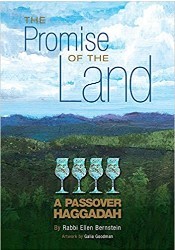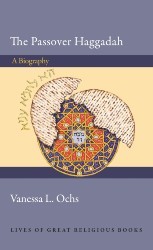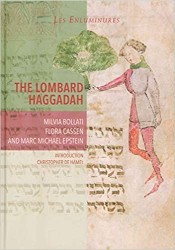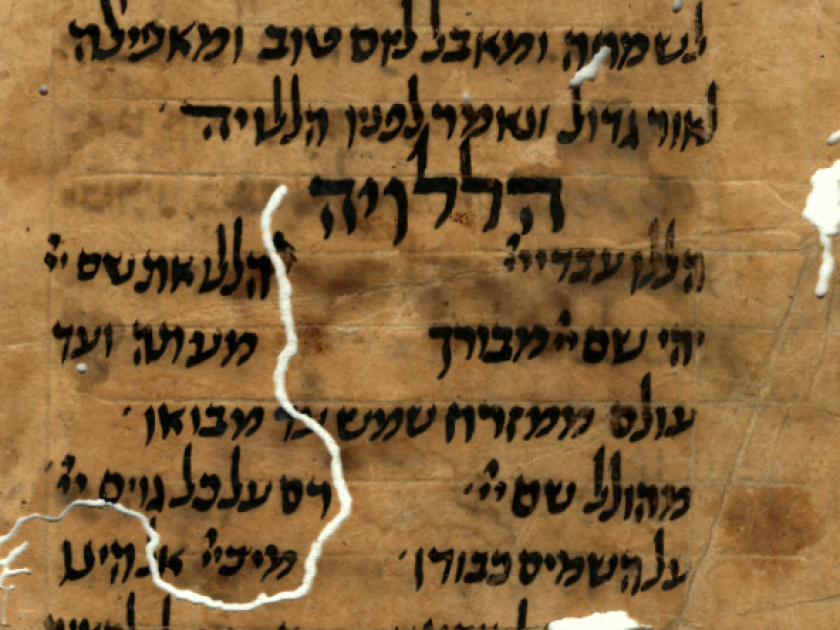
A piece of the Passover Haggadah, found in the Cairo Geniza; Younes and Soraya Nazarian Library, University of Haifa & The Friedberg Genizah Project
Every eon has its eras; every era its periods; every period has its epochs; every epoch has its ages.
Outside of what we learn in Geology class, the two words in my Dickensian opening sentence with which we are vernacularly familiar are “era” and “age.”
There are unending lists of significant cultural human interests that are defined this way. These include the histories of culture, technology, war, crises, mythology, cosmology, medicine, architecture, arts, science, and a list that could go until the next era of everything I’ve listed, plus anything people have brought in to Antiques Road Show.
I would like to suggest that the development of the Haggadah deserves to be placed under a similar rubric, and that the Haggadah Age can be partitioned into the Coalescing Era, the Illuminated Era, the Proliferation Era, the Commentary Era, and the Creative Era.
There is no need to be heavy handed here. I will not cite Haggadot to see into which era they fit. Rather, I’ll outline the history, with a timeline and anecdotes. Let us go back to pre-history, to the Mishnaic and Talmudic periods.
520 BCE: Our earliest possible starting point, aside from Biblical passages, for the Haggadah contents, because most of the text is understood to arise during the second temple period (which ends in 70 CE), as are the central players in the text.
90 BCE: The first ever mention of a Seder service is in the Mishnah of the Talmud by Rabbi Gamaliel. He declares before the legislative body of the Sanhedrin: “One who has not said these three words, Pesah, Matzah, and Maror has not done his duty.”
These words are recorded, included, and thereafter immortalized.
70 CE: The second temple is destroyed, marking the last time an actual Passover sacrifice is offered.
~1st and 2nd centuries: The time of Rabbi Yose, Rabbi Eliezer, and Rabbi Akiva (50−135 CE) whose thoughts on how many plagues were visited upon the Egyptians are recorded for all time.
~170 CE: The earliest possible date for a complete Haggadah to have been created, because Rabbi Yehudah bar Elai exists here, and is the last Tanna quoted in the Haggadah text. Therefore, it must be presumed that the text must have been completed after this time, and not earlier.
~135 – 360 CE. Arguments ensue among various commentators as to the origin of the text based on a short discussion in the talmud in Pesachim 116a. 135 is the birth-year of the compiler of the mishna, Rabbi Yehuda HaNasi, to whom some attribute the Haggadah’s creation. 360 is the time of Rav Nachman bar Yitzchak, who is cited as one of two possible Nachmans who may have compiled the Haggadah text. The other is Nachman bar Yaakov, whose heydey was ~280 CE.
Over the next several hundred years, various parts are added and modified, until finally they are solidified around 700 – 800 CE.
During this time, the Haggadah is generally printed only as an addendum to other printed seforim during this period (e.g. as part of a siddur published by Amram Gaon [whose single intact fragment, dated to ~860, was found in the Cairo Geniza], Saadia Gaon,~928 – 942, and as part of the RaMBaM’s Mishnei Torah, among others), and is only printed outright on its own during the middle of the thirteenth century (some believe that several indpendent Haggadah texts were printed between the 10th and 13th centuries – with the year 1250 believed to be the best approximate date —but these have not survived).
This follows a pattern more common than some might anticipate. Another such paradigm worth watching is the Pri Etz Hadar, the text used by some for Tu B’Shvat seders. This is popular among Chasidim, becoming more popular among the Modern Orthodox, and has very, very few self-standing printed versions. Most Pri Etz Hadars remain as an addendum to other prayer books, and —in my opinion —may soon become popular enough, perhaps, to enjoy its own day in the sun. We are a people of ritual, after all, and this seems like a valuable piece of tradition
The first ever mention of a Seder service is in the Mishnah of the Talmud by Rabbi Gamaliel.
~1300: The Birds’ Head Haggadah, made in Germany and designed for Ashkenazi Jews, can be found in the Israel Museum in Jerusalem today, and whose birds’ head depiction remain a curiosity to this day.
~1320: The Golden Haggadah was created in or around Spain for Sephardi Jews, magnificent and grand in its design and layout, can today be found in the British Library.
~1350: The Sarajevo Haggadah is the most well-known from this era; it is illuminated and entirely in Hebrew. The original can be found in the National Museum of Bosnia in Sarajevo.
1478: The Washington Haggadah, so called because its home is now in Washington, D.C., bedecked with splendid multi-color art with some strange-for-our-time misogynistic twists.
Late 14th century: The Rylands Haggadah, is produced in Spain. Recently, this work visited the Metropolitan Museum of Art in New York.
1526: The Prague Haggadah, comprised of fine woodcut scenes relevant to the text, and scenes that are not, but seem to have a hopeful forward-looking end-of-days redemptive quality. It is the earliest printed Haggadah that exists today in its entirety.
~1450: The printing press is invented, but, curiously, does not immediately induce a marked proliferation of unique texts. This phenomenon is held in abeyance until centuries later. The first item off the “assembly line” is a Latin bible. The first Hebrew prayer book using the press is produced in 1475.
1482: The first speculated date for a Haggadah to come off the printing press, somewhere around Spain. One copy survives and currently lives in the Jewish National University Library in Jerusalem. To think, the first such item in human history has no physical evidence of its publication place, or date.
1486: The first confirmed Haggadah to roll off the printing press is published by the famed Soncino family in Italy.
During this post-printing press era, it seems that there is somewhat of a final drive to add a few more elements and generally codify the text for good. Before the turn of the 16th century, “Chad Gadya” and “Echod Mi Yodaya” are added (to an updated version of the Prague Haggadah, in 1590), leaving all Ahshkenazi, Sefadic, and Mizrahi Haggadot generally the same, save for subtle differences (the inclusion or exclusion of Sefirat Haomer being one of them, plus other minor textual variations).
1505: The first Haggadah to be printed with commentary is the Zevach Pesach, in Constantinople by Yitzchak ben Yehuda Abravanel, known as the Abarbanel.
The next several centuries see general acceptance of the final text, more elaborate illustrations based mostly on the illuminated prototypes cited above, translation into at least 30 world languages.
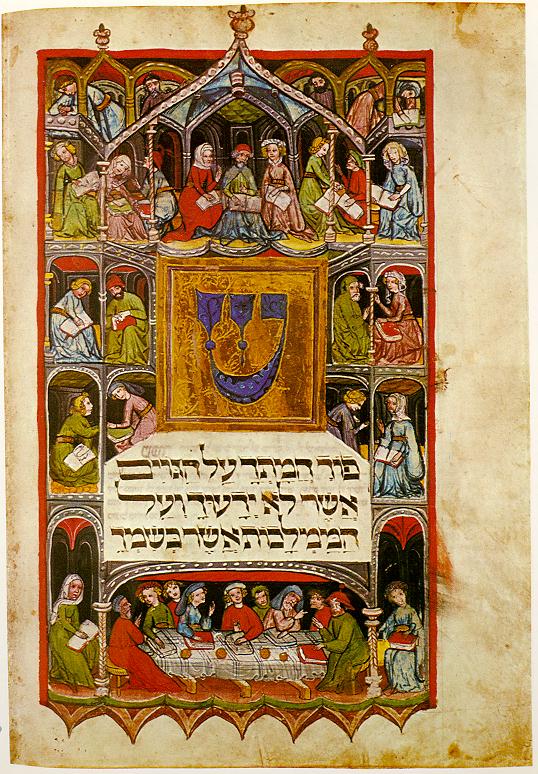
Darmstadt Haggadah, or the Birds Head Haggadah, from Universitäts-und Landesbibliothek Darmstadt
1450: The printing press is invented, but, curiously, does not immediately induce a marked proliferation of unique texts.
Highlights along the way include:
1512: The first Latin translation of the Haggadah, produced by a Franciscan friar, and is the first such translation understood not to have targeted a Jewish audience.
1526 – 1527: The earliest known printing of a complete illustrated Haggadah, called simply “Haggadah Shel Pesach” and also known as Haggadah Shel Gershom Cohen, for its maker, but more popularly known as the Prague Haggadah — for obvious reasons.
1545: The Sefer Zevach Pesach is the first Haggadah printed in Italy, and…
1560: …the famous Mantua Haggadah is printed in Italy. And also…
1609: …the Seder Haggadah Shel Pesach, the first to feature illustrations for the Ten Plagues, is printed in Italy. These three printings are of note because the publishers were Christian. This comes about because Jews are not allowed to own printing presses in the region at the time. This unfortunate circumstance is common for this era. The term “ghetto,” is, unsurprisingly, coined here. Never forget.
1644: The second ever translation into Latin, noteworthy because it is the first Haggadah to include musical notation for its hymns. This is somewhat unfamiliar in the Jewish tradition, as songs are passed down generationally.
1695: The Amsterdam Haggadah is published, and is the first to include a map of the ancient Land of Israel. It is also believed that this is the first Hebrew map of Israel ever printed.
1770: The first English translation in London (with pictures copied from the Amsterdam Haggadah), which heralds a period of English translation firsts that include, but are definitely not limited to: Germany, 1857; Berlin, 1864; Hannover, 1869; Baltimore, 1878; Chicago, 1879; Austria, 1885; Frankfurt, 1887; Hungary, 1890; Israel, 1891; South Africa, 1923; Poland, 1924. And yes, a keen reader will note that the bulk of English translations appeared first in more non-English speaking countries than English speaking ones.
1837: The first Haggadah is printed in the USA, and is proudly titled, “Service for the Two First Nights of the Passover in English and Hebrew, First American Edition.” The first book off the press is at home in the Rosenbach Museum and Library in Philadelphia, Pennsylvania. An updated 1922 version is believed to be the first Haggadah to include the Star-Spangled Banner.
1886: The first Haggadah is produced from the Reform stream, The New Haggadah Shel Pesach.
The nineteenth century is certainly a diffusion period, when a recorded 1,269 new, distinct manuscripts are published, followed by 1,100 in the first half of the twentieth century, and preceded by merely 234 in the eighteenth, 37 in the seventeenth, and 25 total up until the sixteenth century.
1904: The Seder Service is the first Haggadah to be translated by a woman. Lillie Goldsmith Cowen produces what becomes known as the Cowen Haggadah, and is the popular and widely-used in the US (295,000 copies) during the first quarter of the 20th century.
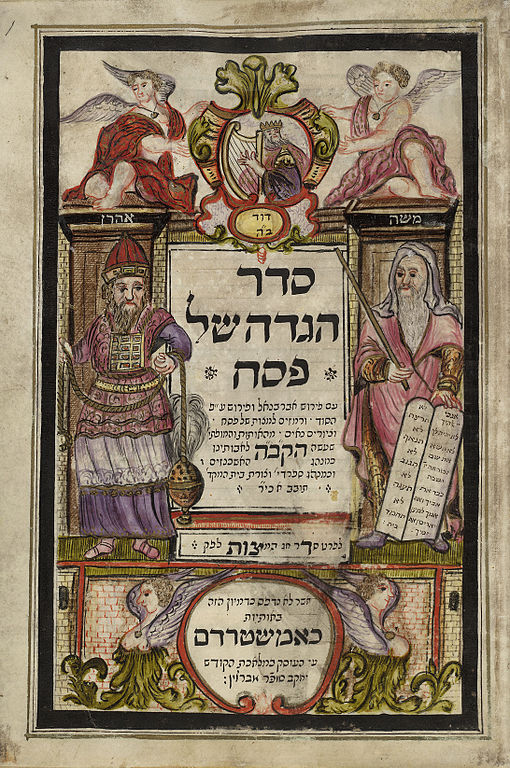
Moses, Aaron the High Priest, and King David, originally published/produced in Hamburg and Altona, 1740, from the British Library digital collections
1904: The Seder Service is the first Haggadah to be translated by a woman.
1907: The Union Haggadah is published, and is the first official Haggadah of the Reform Jewish stream. It is translated to English from German.
1930s: A shift occurs in the Haggadah’s general popularity and interpretability of its meaning.
1932: The Maxwell House Haggadah is published, first intended as a marketing strategy after it was carefully researched and crafted to ensure its “kosher for Passover” status. However, as a minor side effect, it might be said that is the mostly widely used, most instantly recognized, and perhaps best known of all time. What is known with a certainty is that more copies were published than perhaps all other Haggadot combined. That’s a bold thing for me to claim, but I find you can’t argue with 55 million copies. To put into perspective how many that is, it is worth noting that if it were considered a published book (it is perhaps classified as a pamphlet in the larger publishing world), it would rank #17, directly alongside Harry Potter and the Goblet of Fire. If there is any question about its social popularity, I point the reader to the 2009 White Seder, hosted by President Barack Obama. Final mind-blowing fact: it is the longest running advertising campaign in world history, as free Maxwell Haggadot are still offered along with your purchase of Maxwell House coffee.
1934 – 1936: The Polish-Jewish artist Arthur Szyk took a bold leap forward with a Haggadah that contained the classic text, accompanied by arresting watercolors, and drawing direct parallels between the fascist policies of Nazi Germany and the genocidal maneuvers of the pharaoh of the biblical Book of Exodus. This was almost certainly the first Haggadah of its kind to make a social statement. Rejected everywhere, a publishing house was created for the express purpose of publishing this Haggadah. King George VI (father of Her Majesty Queen Elizabeth II) of England received the first copy.
It seems that the popularity of the former and the social statement of the latter supercharged a period of massive creation and distribution, specifically in commentary of a scholarly and social justice nature.
Notable creations along these lines include:
1941: The New Haggadah for the Pesah Seder, speaking for the Reconstructionist movement.
1945 – 1946: A Survivor’s Haggadah, likely having its bold roots in the Szyk Haggadah, is created by Holocaust survivors, and presents the story of the Israelites’ liberation from enslavement in Egypt interwoven with the story of the Shoah.
1946: Rabbi Menachem Mendel Schneerson, the seventh Lubavitcher Rebbe, publishes his thoughts on the Haggadah with the title Haggadah Im Likutei Taamim U’Minhagim.
1953: Rabbi Dr. Paltiel Birnbaum creates the “Seder Hagadah Shel Pesach,” better known as the Birnbaum Haggadah, which experiences immense popularityamong with Orthodox and Conservative audiences.
1969: The Freedom Seder comes to fruitition, comparing ancient Jews to contemporary struggles such as the civil rights movement and women’s movement.
1962: Koren Publishers is launched. Eponymous Haggadot of note include Rabbi Adin’s Steinsaltz’s in 1983, and Chief Rabbi Lord Jonathan Sacks’ in 2006.
1972: The Passover Haggadah, simply named, speaks for the Conservative community.
1972: The Passover Haggadah, simply named, speaks for the Conservative community.
1976: The publishing giant Artscroll. is created and its production of Haggadot materials was immediate, as was its popularity The Artscroll Haggadah, authored by Rabbi Joseph Elias enjoyed widespread use before Artscroll publishededitions from Rabbis Schwab, Scherman, Brander, Weinrib, Reisman, Wallach, Weiss, Twerski, and countless other luminaries.
1979: The Humanist Haggadah, speaking for The Humanistic Jewish movement.
1995: The Stonewall Seder, speaking for the LGBTQ community.
Many, many more Haggadot representing social and political concerns have been created. There are almost too many to mention, but they broadly cover a wide range, including the Black Lives Matter movement, hunger, labor justice issues, global refugee crises, alcohol and drug abuse, and almost every matter of societal or personal oppression.
In the past quarter century or so, Haggadot have embarked on yet another path, veering wildly sometimes from the settled text, and often inflected with a healthy dose of pop culture, attract others who may not have been included along the way. I would say most of this is targeting a younger audience. It could mean that we, as a people, have done our utmost to invite everyone to the table.This is wonderful.
Notable ones include:
2007: 30 Minute Seder: The Haggadah That Blends Brevity With Tradition. A useful and clever creation, designed for an age where getting your attention, for anything, is a rather difficult task.
2008: Richard Codor’s Joyous Haggadah: A Children and Family Cartoon Haggadah for Passover Seder. Plain fun, attractive visually, whose entire purpose is to pull children in and engage them, and with them.
2017: The Zombie Haggadah. In my view, the wildest, strangest, and most metaphor-packed of this whole lot. A thing like this could not have been created in any other generation.
2017: The (unofficial) Hogwarts Haggadah. Rabbi Moshe Rosenberg’s delightful creation builds on the Harry Potter series.
2017: The (unofficial) Hogwarts Haggadah. Rabbi Moshe Rosenberg’s delightful creation builds on the Harry Potter series.
2018: Welcome to the Seder: A Passover Haggadah for Everyone.. Previously, Haggadot were more generally designed to target specific peoples, in specific movements, in specific places, this example, among others, speaks more universally, gathering up anyone left who may have felt overlooked or excluded. Further speaking to this point are copious new Haggadot with inclusive phrases like “For all,” “The Whole Family,” “For All Generations,” “Family Participation,” and the like.
As with the Haggadot addressing social issues, there are too many more that deserve mention, but space is at a premium.
Nevertheless, let us include for the record For this We Left Egypt?, The Kveller Haggadah, A Different Night, The Baseball Haggadah, Lotsa matzah, I Love Matzah, The Jewish Journey Haggadah, The Hip Hop Haggadah, The Hipster Haggadah, and more.
2019: In this proposed Creative Era, two items stand out, at least for me, because both seem to have come full circle, in our culture, and in this presentation. Firstly, we have the most popular (at least according to Amazon) of all: The Passover Haggadah Graphic Novel. A gorgeous comic-bookesque re-showing of the Haggadah that captures the imagination. The text sits squarely in our current era, but also harkens back to the Illuminated Era, creating a bridge to the past while modernizing slightly
The other item is my very own creation, The Emoji Haggadah, about which I cannot escape complete bias I worked to create discussion, and inclusion, and presence at the seder table. 2020: Scouring the landscape of Haggadot printed for Passover 5780, I have found (Tablet’s) The Passover Haggadah: An Ancient Story for Modern Times, The Passover Haggadah: A Biography, The Haggadah for The Generations 2020: Connecting the Seder to your family’s history, The Human Rights Haggadah, At The Maggid’s Seder, The Promise of the Land: A Passover Haggadah, and Koren Youth Haggada, Magerman Edition. All are wonderful creations, and useful, but don’t seem to be pushing the envelope too much. Perhaps an era has closed, and another is about to be launched. Perhaps the era is taking a breath, to be invigorated soon. I am trying to keep it going by having recently published The Festivus Haggadah, a fusion of the Seinfeld canon and the classic Haggadah. I am intentionally pushing this into the larger culture. In this attempt, I am following the lead of one Dave Cowen, who delivered a very similar one-two punch, with humor at the base, with 2018’s The Trump Passover Haggadah, and 2019’s The Yada Yada Haggadah.
Perhaps a Silly Era is nigh, having coming quite far to get here after all this time, and if humor does not pull in the final few left who have not yet been invited to the seder table, time will tell what else can be done.
At this point in history, 3,000 different versions of the Haggadah are believed to have been created, and counting. We have humbly brought forth about 2% of this number for our discussion. May Haggadot of all sorts, speaking for all kinds, remain at your table, for all generations.
Next year in Jerusalem!
Martin Bodek is the author of The Emoji Haggadah, The Festivus Haggadah, The Coronavirus Haggadah, the recently published The Shakespeare Haggadah, and six other books.
